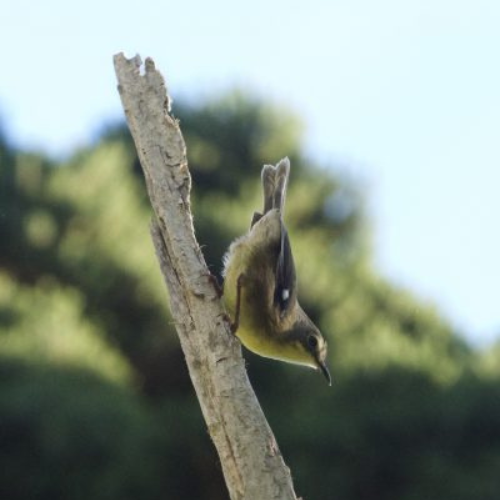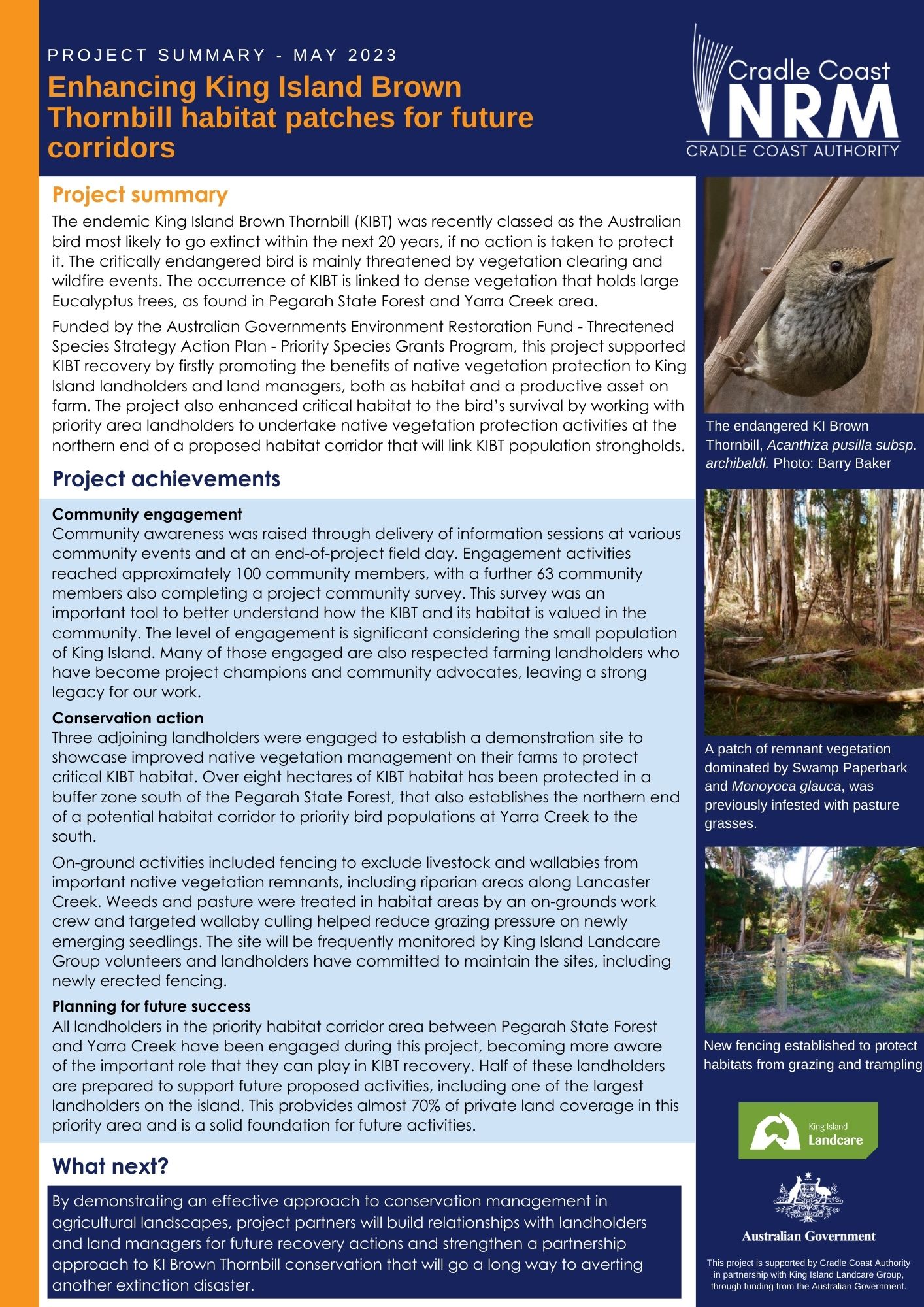
KING ISLAND SCRUBTIT AND KING ISLAND BROWN THORNBILL PROTECTION
Community action for King Island threatened bird recovery
This project will implement actions across King Island to protect the habitat of two priority species listed in the Threatened Species Action Plan 2022-2032, the King Island Brown Thornbill and King Island Scrubtit. Actions to be undertaken are aimed at protecting high-quality habitat with improved conservation management, reducing weed and feral animal threats to the birds, improving the quality and extent of their habitat by connecting remnant habitat patches with corridors across agricultural land, and building the capacity of landholders and community groups on King Island to address known threats to native species.
Feral cat control on King Island using Felixer cat grooming traps
From 21 April 2024, four Felixer Feral Cat Grooming Traps will be used to target feral cats on King Island. This is part of an Australian Government-funded project to reduce threats to the critically endangered King Island Brown Thornbill and King Island Scrubtit.
These traps will be deployed and regularly serviced by licensed professionals, warning signs will be displayed at entrances to the property and within 50 m of each trap.
What is a Felixer grooming trap and how does it work?
The Felixer cat grooming trap is a new and innovative method for controlling feral cat populations. The device contains a camera, data processing unit and cartridges of 1080 poison.
When the device identifies the animal passing in front of its camera as a cat, it squirts a dose of gel containing 8 mg of 1080 poison (sodium fluoroacetate) onto the animal’s fur. The poison is then ingested when the animal grooms its fur. This takes advantage of the fact that feral cats are often reluctant to enter traps, but they do instinctively and fastidiously groom themselves, unlike native animals.
How do Felixers know it’s a cat?
Felixers were developed specifically as an automated and humane tool to help reduce the number of feral cats, thereby improving the welfare and survival of native animals. Previously the devices used laser sensors to determine the size, shape and gait of animals, allowing them to specifically target cats. The new V3.2 Felixer™ with Artificial Intelligence has been developed to further minimise the possibility of targeting native species.
Why do we need Felixers?
To date, the primary methods of cat control on King Island have been domestic cat management and trapping of strays and feral cats. To protect threatened species that are vulnerable to feral cat predation, additional effective effort is required. Because Felixers are automated, less human effort is required to trap and euthanise cats, and remote locations can be targeted.
Felixer cat grooming traps do not resemble traditional traps and are effective at targeting cats that may have become wary of traps. This provides a promising new method for protecting native species and ecosystems from the negative impacts of feral cats.
What are the risks to native and domestic animals?
Sodium flouroacetate or 1080 is used in Felixers because a very small dose is required to kill a cat (< 8 mg) whereas native Australian animals tend to have a higher tolerance.
The Felixer deployment on King Island comes after a non-lethal trial of four devices for four months which was used to assess the risks posed to non-target species and their efficiency in targeting feral cats.
Throughout this trial, 2720 non-target individual animals (including wallabies, pademelons and birds) were detected and only one was misidentified as a target. This was a Bennett’s Wallaby.
These results indicate that the potential risk to non-target, native species is negligible.
During the four-month trial period there were 69 cat detections correctly identified as targets by the device. There were likely at least 6 individual cats (with repeated detections) that would have been killed by the devices across three properties.
Each device keeps a photographic record of all animals detected by the sensors, including all animals targeted. These photos will be regularly reviewed to ensure there is no risk to native animal populations.
Like other pest control techniques such as baiting, there is a small risk that domestic animals may be targeted. The neighbours of the properties with active Felixer devices have been advised to keep pet cats indoors, and for extra risk management, some pets have been issued with a Bluetooth device that can be fitted to an animal’s collar. The Bluetooth device deactivates the Felixer when it is within range of the machine so the pet cat will not be targeted.
However, the Felixers will be deployed on conservation covenants or primary production land, where domestic animals are not allowed and access can be managed. Signage will also be installed either side of the devices and at the entrances to properties where the Felixers are operating.
What about secondary poisoning?
Secondary poisoning refers to a situation where an animal consumes another animal that has died as a result of poisoning. In the case of Felixers, a feral cat that is targeted is sprayed with a gel containing a very small dose (8 mg) of 1080 which it grooms from its fur. After ingesting the gel, it distributes throughout the cells of the cat, so a scavenger would need to eat the whole cat (~5 kg) very soon after death to receive the full dose of poison. Any 1080 gel remaining on the coat of a sprayed cat rapidly degrades due to microorganism activity and UV radiation and is therefore not deemed a likely source of secondary poisoning. Studies from other parts of Australia have also confirmed this.
Will it work?
Yes! Felixer devices have been used since 2015 across Australia and on off-shore islands in cat eradication and cat suppression, in order to protect threatened species and ecosystems from the impacts of feral cats. The data from local non-lethal trials demonstrate that they could also be a very effective tool for cat control on King Island.
More information about Felixer traps can be found at: www.thylation.com/felixer-faqs/
Image 1: A Felixer device ready to help control feral cats. Image 2: A cat photographed by a Felixer on King Island.
Defining and mapping habitat requirements to support the survival of King Island Scrubtit and King Island Brown Thornbill
This project is conducting important bird surveys on King Island, to improve our understanding of the distribution and habitat requirements of the critically endangered King Island Scrubtit and King Island Brown Thornbill. These two birds are among the five Australian bird species considered most likely, in the absence of intervention, to become extinct within 20 years. We are also conducting vegetation surveys to improve accuracy of mapping of important native vegetation communities and habitat for these birds. This will aid future landscape scale planning and management of critical biodiversity assets.
January 2023 Report prepared by Phil Bell and Matt Webb, Biodiversity Maintenance Australia.
Enhancing King Island Brown Thornbill habitat patches
In partnership with King Island Landcare Group (KILG), Cradle Coast Authority, received funding from the Australian Government and Environment Restoration Fund (ERF) to recover and create new habitat for the KIBT via vegetation restoration. The project aims towards creating a vegetation corridor that will also serve other King Island critically endangered species, such as the King Island Scrubtit, Black Currawong or the latest addition to the list of endangered, the KI Yellow Wattlebird.
In the news
Project contact:
Nicky Loane, Project Officer nloane@cradlecoast.com
Iona Flett, Biodiversity Program Manager iflett@cradlecoast.com





